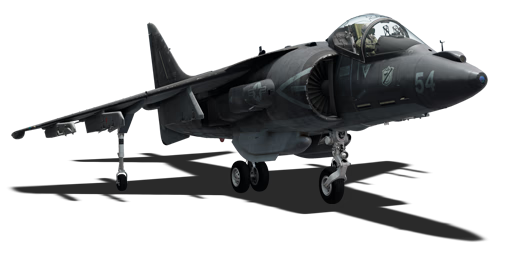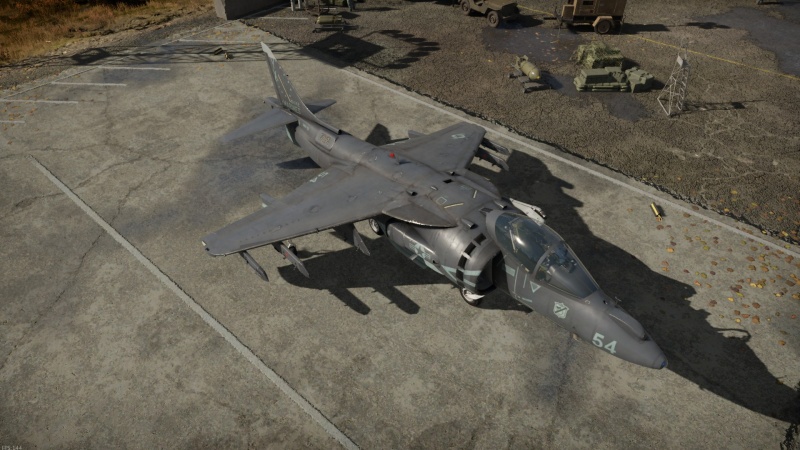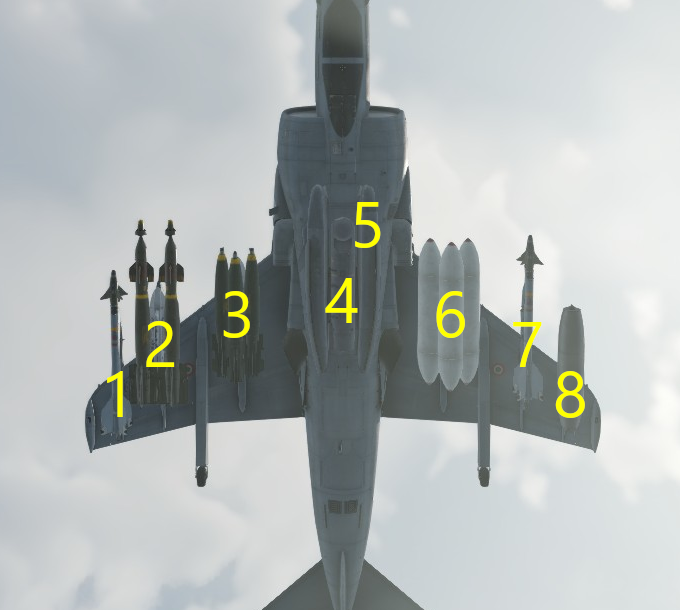Difference between revisions of "AV-8B (NA)"
(→Details: I added multiple features about the aircraft and how it behaves in GRB and ARB, I own this aircraft and have been using it sense it came out, all information is wrote by me.) (Tag: Visual edit) |
(→History) (Tag: Visual edit) |
||
| Line 228: | Line 228: | ||
'''Pros:''' | '''Pros:''' | ||
| − | |||
* Large number of payload options, including the AGM-65 Maverick, GBU guided bombs, and JDAMs | * Large number of payload options, including the AGM-65 Maverick, GBU guided bombs, and JDAMs | ||
* All-weather combat capability and LITENING II targeting pod | * All-weather combat capability and LITENING II targeting pod | ||
| Line 241: | Line 240: | ||
* Mediocre flight capabilities | * Mediocre flight capabilities | ||
* Extremely limited ammo count for the autocannon | * Extremely limited ammo count for the autocannon | ||
| + | * Does NOT get VTOL. | ||
== History == | == History == | ||
Revision as of 19:16, 23 September 2024
| This page is about the American jet fighter AV-8B (NA). For other versions, see Harrier (Family). |
Contents
Description
The AV-8B (NA) Harrier is a premium gift rank VII American strike aircraft with a battle rating of 11.3 (AB/RB) and 11.7 (SB). It was introduced in Update "Dance of Dragons".
General info
Flight performance
The AV-8 has a great zero to takeoff speed, just like all other harriers, however, this harrier does NOT get any VTOL (Vertical Takeoff Or Landing) and the engine overheats very quickly when at 90%-110% so be sure to keep it bellow that number. This aircraft has overall decent maneuverability, but you will bleed speed when doing a high G turn. This aircraft can also hold up to 4 AIM-9L's, which can allow multiple kills on distracted enemies. One great part of this aircraft is it's usefulness in Ground RB allowing guided bombs, unguided bombs, and ATGM's (Air To Ground Missiles).
| Characteristics | Max speed (km/h at 0 m - sea level) |
Max altitude (metres) |
Turn time (seconds) |
Rate of climb (metres/second) |
Take-off run (metres) | |||
|---|---|---|---|---|---|---|---|---|
| AB | RB | AB | RB | AB | RB | |||
| Stock | ___ | ___ | 12192 | __._ | __._ | __._ | __._ | 550 |
| Upgraded | 1,134 | 1,125 | 29.2 | 30.0 | 111.4 | 90.0 | ||
Details
| Features | |||||
|---|---|---|---|---|---|
| Combat flaps | Take-off flaps | Landing flaps | Air brakes | Arrestor gear | Drogue chute |
| X | ✓ | ✓ | ✓ | X | X |
| Limits | ||||||
|---|---|---|---|---|---|---|
| Wings (km/h) | Gear (km/h) | Flaps (km/h) | Max Static G | |||
| Combat | Take-off | Landing | + | - | ||
| 1,137 | 648 | - | ___ | ___ | ~__ | ~__ |
| Optimal velocities (km/h) | |||
|---|---|---|---|
| Ailerons | Rudder | Elevators | Radiator |
| < ___ | < ___ | < ___ | - |
Engine performance
| Engine | Aircraft mass | |||||
|---|---|---|---|---|---|---|
| Engine name | Number | Basic mass | Wing loading (full fuel) | |||
| Rolls-Royce Pegasus F402-RR-406 | 1 | _,___ kg | ___ kg/m2 | |||
| Engine characteristics | Mass with fuel (no weapons load) | Max Gross Weight | ||||
| Weight (each) | Type | _m fuel | __m fuel | __m fuel | ||
| ___ kg | ___ | _,___ kg | _,___ kg | _,___ kg | _,___ kg | |
| Maximum engine thrust @ 0 m (RB/SB) | Thrust to weight ratio @ 0 m (___%/WEP) | |||||
| Condition | 100% | ___%/WEP | _m fuel | __m fuel | __m fuel | MGW |
| Stationary | ___ kgf | ___ kgf | _.__ | _.__ | _.__ | _.__ |
| Optimal | ___ kgf (_ km/h) |
___ kgf (_ km/h) |
_.__ | _.__ | _.__ | _.__ |
Survivability and armour
The AV-8B (NA) lacks any internal or external armour, and has little chance of survival when encountering a close hit or direct impact of SAM or AAMs. However, VTOL capabilities could help slightly, as it would be easier to land a wounded AV-8B compared to other jets not capable of vertical landing.
Modifications and economy
Armaments
| Ballistic Computer | ||||
|---|---|---|---|---|
| CCIP (Guns) | CCIP (Rockets) | CCIP (Bombs) | CCRP (Bombs) | EEGS |
| |
|
|
|
|
Offensive armament
The AV-8B (NA) is armed with:
- 180 x countermeasures
Suspended armament
The AV-8B (NA) can be outfitted with the following ordnance:
| 1 | 2 | 3 | 4 | 5 | 6 | 7 | 8 | ||
|---|---|---|---|---|---|---|---|---|---|
| 25 mm GAU-12/U cannons (300 rpg) | 1 | ||||||||
| 250 lb LDGP Mk 81 bombs | 1 | 3 | 3 | 2 | 3 | 3 | 1 | ||
| 250 lb Mk 81 Snakeye bombs | 1 | 3 | 3 | 2 | 3 | 3 | 1 | ||
| 500 lb LDGP Mk 82 bombs | 1 | 3 | 3 | 2 | 3 | 3 | 1 | ||
| 500 lb Mk 82 Snakeye bombs | 1 | 3 | 3 | 2 | 3 | 3 | 1 | ||
| 1,000 lb LDGP Mk 83 bombs | 1 | 2 | 2 | 1 | |||||
| 500 lb GBU-38(V)2/B JDAM bombs | 2 | 3 | 3 | 2 | |||||
| 277 kg GBU-12 Paveway II bombs | 2* | 3* | 3* | 2* | |||||
| 1,092 lb GBU-16 Paveway II bombs | 1* | 1* | 1* | 1* | |||||
| Mk 77 mod 4 incendiary bombs | 1 | 2 | 2 | 2 | 2 | 1 | |||
| FFAR Mighty Mouse rockets | 38 | 57 | 57 | 38 | |||||
| Zuni Mk32 Mod 0 ATAP rockets | 8 | 12 | 12 | 8 | |||||
| AGM-65E2 missiles | 1* | 1* | 1* | 1* | |||||
| AGM-65G missiles | 1 | 1 | 1 | 1 | |||||
| AIM-9L Sidewinder missiles | 1 | 1 | 1 | 1 | |||||
| LITENING II targeting pod | 1* | ||||||||
| * The LITENING II pod must be equipped when carrying laser-guided munitions | |||||||||
| Default weapon presets | |
|---|---|
| |
Usage in battles
Describe the tactics of playing in the aircraft, the features of using aircraft in a team and advice on tactics. Refrain from creating a "guide" - do not impose a single point of view, but instead, give the reader food for thought. Examine the most dangerous enemies and give recommendations on fighting them. If necessary, note the specifics of the game in different modes (AB, RB, SB).
Pros and cons
Pros:
- Large number of payload options, including the AGM-65 Maverick, GBU guided bombs, and JDAMs
- All-weather combat capability and LITENING II targeting pod
- All-aspect AIM-9L missiles
- 180 countermeasures
- Hard-hitting gun, with SAPHEI, HVAP, and HEI rounds
Cons:
- Subsonic, cannot exceed Mach 1 in level flight
- Lacks a radar or radar-guided missiles
- Mediocre flight capabilities
- Extremely limited ammo count for the autocannon
- Does NOT get VTOL.
History
As the first generation of the Hawker Siddeley Harrier, designated as the AV-8A and the Harrier GR.1, came into use, several drawbacks were revealed including limited combat radius, low payload delivery, lack of ECM (electronic countermeasure) systems, etc. While some problems could be addressed with the installment of improved avionics (resulting in the AV-8C and Harrier GR.3), issues in payload delivery required a redesigned fuselage and engine. Thus, Hawker Siddeley and McDonnell Douglas began to develop a more advanced version of the Harrier with a larger fuselage and the Pegasus engine, unofficially dubbed the "AV-16", due to the goals of producing a plane with twice the payload and range of the AV-8. In 1975, however, the RAF pulled out of the project due to budget constraints, and the USMC was unwilling to sponsor the project by itself, resulting in its cancellation in the same year. Since then, McDonnell Douglas began to design a new Harrier based on the existing AV-8A, reconfiguring two AV-8As with redesigned wings, intake, exhaust nozzles, and other aerodynamic changes, leading to the YAV-8B. Further tests with YAV-8B regarding payload delivery, range, and VTOL capabilities proved satisfactory, and the AV-8B was officially procured by the USMC as its new generation of VTOL strike aircraft.
In 1985, McDonnell Douglas sought to enhance the all-weather capability of the AV-8B, fitting it with FLIR (Forward Looking Infrared) sensors, Hughes AN/ASB-19 ARBS (Angle Rate Bombing System), F-402-RR-408 engine, and an improved HUD and MFD, offering night attack capabilities. Though initially called the AV-8D, this new variant came into service in 1987 designated the AV-8B (NA), or the Harrier Night Attack variant.
The AV-8B saw extensive combat during its long service history. It was first used in Operation Desert Storm where AV-8Bs based on the USS Nassau and USS Tarawa supported coalition forces in the Battle of Khafji, dropping guided munitions on Iraqi artillery and provided support for USMC and coalition forces. Later, during Operation Enduring Freedom in 2001 and Operation Iraqi Freedom in 2003, AV-8Bs were deployed at forward operation bases (FOBs) due to their STOL/VTOL capabilities and had a much faster response time compared to USAF and USN aircraft, which had to take off from airfields in Kuwait, Saudi Arabia, or carriers. AV-8Bs carrying LITENING targeting pods flew reconnaissance missions and dropped guided munitions on Al-Qaeda forces and the Iraqi military, flying over 5000 sorties and demolishing a large number of Taliban and Iraqi vehicles and personnel. AV-8Bs also took part in Operation Odyssey Dawn. When a USAF F-15E crashed in Libya due to mechanical failure, both pilots ejected successfully and were stranded deep in enemy territory. Two AV-8Bs dropped 250lb Paveway munition to deter Libyan ground forces from approaching the pilots, and one of the AV-8Bs dropped additional munitions on the wreckage of the F-15E to prevent it from falling into enemy hands. All AV-8B (NA) and AV-8B Plus continue to serve until 2025, by then replaced by newer F-35Bs.
Media
Excellent additions to the article would be video guides, screenshots from the game, and photos.
See also
Links to the articles on the War Thunder Wiki that you think will be useful for the reader, for example:
- reference to the series of the aircraft;
- links to approximate analogues of other nations and research trees.
External links
| McDonnell Aircraft Corporation | |
|---|---|
| Jet Fighters | F2H-2 · F3H-2 |
| F-4C Phantom II · F-4E Phantom II · F-4J Phantom II · F-4S Phantom II | |
| F-15A · F-15C MSIP II · F-15E | |
| Strike Aircraft | AV-8B Plus · AV-8B (NA) |
| Helicopters | AH-6M |
| Export/Licensed | |
| Aircraft | ◄F-4F Early · ◄F-4F · ◄F-4F KWS LV · Phantom FG.1 · Phantom FGR.2 · F-4J(UK) Phantom II · F-4EJ Phantom II · F-4EJ ADTW · Kurnass · Kurnass 2000 |
| F-15J · F-15J(M) · Baz · Baz Meshupar · F-15I Ra’am | |
| ▄AV-8B Plus | |
| Helicopters | Lahatut |
| The McDonnell Aircraft Corporation merged with Douglas Aircraft Company in 1967 to form McDonnell Douglas Corporation. Later it was merged with The Boeing Company in 1997. | |
| See Also | Mitsubishi Heavy Industries |
| USA jet aircraft | |
|---|---|
| Fighters | |
| F9F | F9F-2 · F9F-5 · F9F-8 |
| F-80 | F-80A-5 · F-80C-10 |
| F-84 | F-84B-26 · F-84F · F-84G-21-RE |
| F-86 | F-86A-5 · F-86F-25 · F-86F-2 · F-86F-35 |
| F-89 | F-89B · F-89D |
| F-100 | F-100D |
| F-104 | F-104A · F-104C |
| F-4 | F-4C Phantom II · F-4E Phantom II · F-4J Phantom II · F-4S Phantom II |
| F-5 | F-5A · F-5C · F-5E · F-20A |
| F-8 | F8U-2 · F-8E |
| F-14 | F-14A Early · ▄F-14A IRIAF · F-14B |
| F-15 | F-15A · F-15C MSIP II · F-15E |
| F-16 | F-16A · F-16A ADF · F-16C |
| Other | P-59A · F2H-2 · F3D-1 · F3H-2 · F4D-1 · F11F-1 |
| Strike Aircraft | |
| FJ-4 | FJ-4B · FJ-4B VMF-232 |
| A-4 | A-4B · A-4E Early |
| A-7 | A-7D · A-7E · A-7K |
| AV-8 | AV-8A · AV-8C · AV-8B Plus · AV-8B (NA) |
| A-10 | A-10A · A-10A Late · A-10C |
| F-111 | F-111A · F-111F |
| Other | A-6E TRAM · F-105D · F-117 |
| Bombers | |
| B-57 | B-57A · B-57B |
| USA premium aircraft | |
|---|---|
| Fighters | Thach's F2A-1 · Galer's F3F-2 · F2G-1 · F4U-4B VMF-214 · P-26A-34 · Rasmussen's P-36A · P-40C · P-43A-1 |
| P-47M-1-RE · ⋠P-47M-1-RE · P-51A · P-51D-10 · P-51D-20-NA · ␠Kingcobra · XP-55 | |
| ▃A6M2 · ▃Ki-43-II · ▃Ki-61-Ib · ▃Bf 109 F-4 · ▃Fw 190 A-8 · ▃Spitfire LF Mk IXc | |
| Twin-engine fighters | XP-38G · Bong's P-38J-15 · P-38K · YP-38 · P-61A-11 · XF5F · XP-50 · F7F-3 |
| Jet fighters | P-59A · F-86F-35 · F-89B · F-89D · F-4S Phantom II · F-5C · F-20A |
| Strike aircraft | A-1H · A2D-1 · AU-1 · XA-38 · AV-8A · AV-8B (NA) · A-6E TRAM · A-10A |
| Bombers | A-26C-45DT · B-10B · BTD-1 · PBM-3 "Mariner" · PBM-5A "Mariner" · PV-2D |






